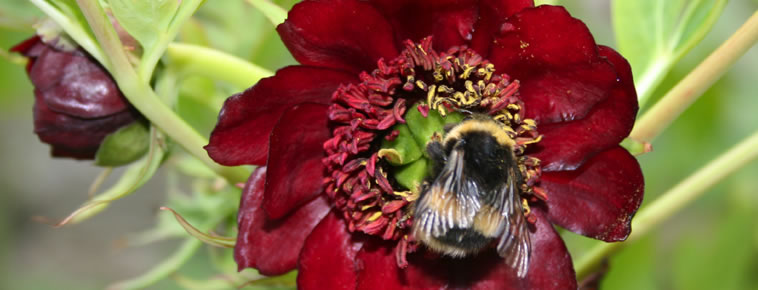
MARCH AT CLUNY
March can be such an exciting time with spring (hopefully rapidly!) approaching. Frosts early in the month can be damaging especially to the first flowering rhododendrons.
BULBS
This month and next the garden is alive with flowering bulbs. Early in the month a number of different species and hybrid snowdrops, Galanthus, flower throughout the garden along with their near relative, snowflakes Leucojum vernum. There are 2 species of miniature daffodils Narcissus minor which can be seen slowly spreading at No 2 and N. cyclamineus between 17 & 18. There are different Crocus along with Cyclamen, Scilla & Muscari especially in the top area of the garden. Around the middle of March, the first Trilliums (American Wood Lilies) & Fritillaries should be in flower. Look out for white T. ovatum, usually the first to show especially in the bed opposite the car park and T. chloropetalum var giganteum, a very large Trillium up to 40cm, with highly mottled leaves. Later in March, the first Dog’s Tooth Violets, Erythronium revolutum, in pink and with recurving petals will be in flower. The large stalks (some over 3 metres) are last year’s seed heads of Cardiocrinum giganteum, the Giant Himalayan Lily, which can still be seen in position at the top of the garden. They look like similar to Venus Fly Traps!
HELLEBORES
The Stinking hellebore or Dungwort Helleborus foetidus, grows prolifically throughout the top half of the garden and has been flowering since January. The Lenten rose Helleborus orientalis and their subspecies have a large range of flower colour from almost pure white, to pink, to red and some are highly spotted. All are very beautiful, lasting many weeks to be followed by attractive seed heads. There are other species of hellebore to be found in the garden including H. purpurescens and argutifolius.
PRIMULAS
Cluny is famed for its Asiatic primula collection. Amongst the first to flower is the pale blue-pink Primula hoffmaniana with the unusual feature of propagating by runners with next year’s flowering plants on the end of each runner. There are large spreading carpets of it around Nos 18 & 19. During the month other primulas flowering in damper areas include rich purple P. bracteosa, pink P. scapigera and pinky-purple P. gracilipes.
TREES & SHRUBS
Now, before the leaves come onto the trees, is the time to appreciate many of Cluny’s evergreen trees and shrubs and also to be aware of the structure of the garden. The first rhododendrons flower in March but as there can still be severe frosts at this time, the flowers can be badly damaged. Wonderfully scented evergreen Mahonia is found in different places in the garden. A large one is on the left between Nos. 30 & 31. Its bright yellow flowers contrasting with the dark green sharply toothed leaves. The first Daphnes begin to flower, particularly D. mezereum and D. laureola the former with pink/purple scented flowers, the latter with yellow-green slightly scented flowers. Both are native to the UK. Another highly scented low growing shrub with tiny white flowers is Sarcococca hookeriana (sweet box), not easily seen but smelled in many areas of the garden!
HERBACEOUS PLANTS
At Nos. 18, 19 & 20, there is a large spreading carpet of Pulmonaria or Lungwort with flowers of various hues of purple and blue, and varied amounts of leaf spotting. Dotted throughout the garden are clumps of white/cream Cardamine enneaphylla (nine leaved toothwort) and purple Cardamine pentaphylla (showy toothwort) rhizomatous perennials from cooler parts of southern Europe. Another European woodland genus very slowly increasing in the garden is Hepatica related to Anemone. The various species have delicate and beautiful little, white, purple or blue flowers. A few different delicate types of Corydalis (Greek for crested lark) can be spotted flowering in blue, white, pink and red. Primroses and oxlips will also be flowering later in the month.
WILDLIFE
You should easily see one of our resident Red Squirrels. They can regularly be found feeding on the bird feeders around the car park area and at No.5. At this time of year, they can often be heard running up and down the trees. Please speak to one of us if you have not been lucky enough to see one. Going quietly around the garden can be very rewarding. There are plenty of garden birds especially on the feeders including various tits, siskins, chaffinches, greenfinches, goldfinches, blackbirds and robins. It is great that we now have Nuthatches, frequently heard especially in the mornings or seen at the bird feeders. Great-spotted woodpeckers can be heard drumming especially in the top area of the garden while mistle and song thrushes, great and coal tits will be singing their hearts out on mild days. Look and listen for buzzards mewing overhead as well as “cronking ravens” or perhaps even a sparrowhawk. Treecreepers, goldcrests and bullfinches are resident and often very visible while jackdaws have been guarding their chimney nest sites all winter. Stoats are often seen mainly in the top part of the garden. Towards the end of the month we hope to see signs of toads and frogs in the garden and the first butterflies.
MARCH JOBS
We have path repairs to do, gravel to spread and wood to transport up from the bottom half of the garden. Any open spaces are being planted up with herbaceous plants such as primulas or meconopsis, and young trees or shrubs. We are clearing away dead plant material from the beds and covering them with a layer of 2 to 3 year old leaf mould to suppress weeds and provide nutrients. Elsewhere we are re-potting and splitting up herbaceous plants for sale. If you see one of us working in the garden and you have any questions, we would be delighted to answer them, if we can.

